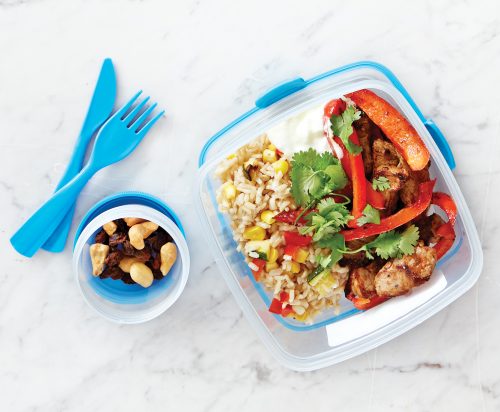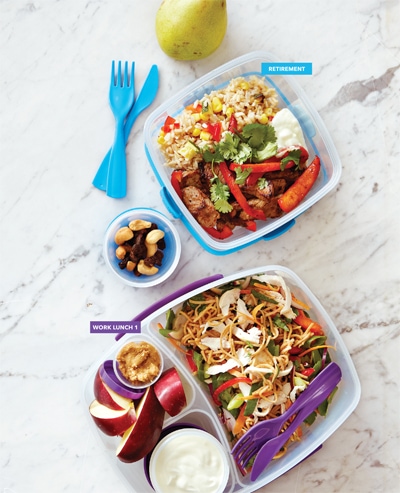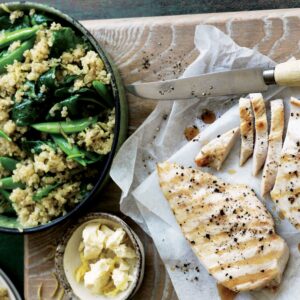
Lunch is often neglected in our meal planning, but a healthy lunch is important to make sure you’ve got enough energy to last the day, whatever stage of life you’re in. Dietitian Katrina Pace explains.
As we get older, our nutrition needs change, and this is reflected in what makes good lunch choices. Pre-schoolers, on the go all the time, need small and frequent snacks during the day to provide all they need. As children grow, their physical changes often determine which nutrients they need more of, such as calcium for growing strong bones and iron during puberty. At university or work, a healthy lunch depends on what we’re doing. A builder, nurse or fitness trainer would have very different lunch needs to someone who sits all day in an office or truck. And when retirement rolls around, our energy needs are not as great as when we were younger.
Taking a lunch to school, university or work puts you in control of what, and when, you eat.
For some parents, packed lunches can be a battleground. Getting the balance between a healthy lunch and foods that will be eaten can be difficult. Getting children involved in packing their own lunches and presenting foods in different ways (such as wraps, triangle sandwiches, or dips and vege sticks) helps increase their interest.
The morning rush can be a stumbling block for packing a lunch. Having a plan of what you’re going to eat and having the ingredients ready to go is one way to make the morning rush less stressful. Think about packaging up a few days’ worth of lunches and keeping them in the cupboard or fridge.
Here are some ideas for tasty packed lunches, to give each age group the nutrients they need.
Pre-schooler
Nutrient needs
Pre-schoolers are on the go the whole time and only have small stomachs to process food. Packing extra snacks, as well as lunch, for the littlies means that they get top-up nutrition throughout the day. Rye crackers can be a good swap for multigrain bread, but rice crackers can be low in fibre and high in salt, so not such a good choice.
Weekly variety is really important as pre-schoolers tend to balance their nutrients over the week. Encourage children to try different types of food by mixing up how you present it to them.
Great lunchbox
Snack (700kJ)
- 1 Choc chip banana and oat mini muffin
- 1/2 mandarin (peeled into segments) and 1/2 carrot (chopped into chunks), mixed with 2x2cm chunks cheese
Lunch (1350kJ)
- 1 slice multigrain bread with 1 tablespoon cream cheese, 1 tablespoon raisins and 1 tablespoon diced red capsicum filling. Cut into triangle sandwiches to serve
- 1 tablespoon each frozen edamame beans and blueberries
- Fruit yoghurt pottle
Primary school student
Nutrient needs
With lots of learning and playing, school kids need long-lasting energy to keep their body and brain on full power all day. Steer clear of the lollies – the way to get long-lasting energy is through carbohydrates, such as high- fibre breads, high-fibre crackers and beans.
Great lunchbox
Snack (800kJ, 30g carbs)
- 1 Homemade muesli bar
- 1/2 apple sliced (wrapped to keep airtight)
Lunch (1800kJ, 40g carbs)
- 1 wholemeal wrap filled with 3 falafel patties, light mayo, 1/4 cup grated carrot, 1/4 cup grated cheese
- 1 tablespoon sultanas
- 1/4 cup each strawberries and chopped watermelon mixed with 1 tablespoon blueberries
Intermediate or high-school student
Nutrient needs
For older children, lunch is a great chance to top up on much-needed calcium. At this stage of life, adolescents and teens are building strong bones that need to last a lifetime. Calcium is crucial to this, but often this is when older children stop having milk and yoghurt. Iron is also important for girls but, again, this is an age when their intake can slow down.
Great lunchbox
Snack (1200kJ, 70mg calcium, 2mg iron)
- 3 dried apricot halves and 1 tablespoon cashews
- 2 Choc-cranberry bliss balls
Lunch (2200kJ, 310mg calcium, 2mg iron)
- Homemade roll with beetroot, chicken, sweet chilli sauce or relish, grated carrot, baby spinach and sweetcorn
- Fruit yoghurt pottle

University student
Nutrient needs
Being at university can mean lots of sitting and studying. Boost your brain power by packing the omega-3 fats, nuts and veges into your lunch. Sticking to these foods, rather than reaching for an energy drink, will give you a post-lunch energy burst, rather than the need for a nana-nap.
Great lunchbox
Snack (500kJ, 3g protein)
- 3 walnut halves, 2 Brazil nuts, 1/2 cup chopped carrot
Lunch (2600kJ, 1.8g omega-3, 30g protein)
- 2 wholemeal crackers
- Salad bowl: 95g tin salmon drained and mixed with 2 tablespoons mayo, 2 cups green salad leaves, 1/4 avocado and 1/3 cup canned chickpeas
- 2 Raisin, date and apricot cocoa balls
Work lunch
Nutrient needs
A great lunch is essential to keep your energy levels up all afternoon. Stop the afternoon slump and sweet cravings by packing protein into your lunch. Bringing your own snack to work can help to remove the temptation of an oversized muffin with your morning coffee.
Great lunchbox 1
Snack (500kJ, 3g protein)
- 1 sliced apple with 2 teaspoons peanut butter.
Lunch (2700kJ, 46g protein)
- Soba noodle salad (with chicken)
- 1/2 cup low-fat plain yoghurt
Great lunchbox 2
Snack (400kJ, 4g protein)
- 2 mixed grain Cruskit crackers, 1 carrot (sliced) and 1 tablespoon cottage cheese (served as a sandwich).
Lunch (2750kJ, 36g protein)
- PLT (pork, lettuce and tomato) sandwich with honey-mustard dressing
- 1 banana
- 2 Fruity avocado bliss balls
Retirement
Nutrient needs
You might be having a light lunch or a cooked lunch, but either way your favourite foods should include protein and fibre foods. As you get older, protein is essential to keeping your muscles strong and preventing falls. Fibre gives your bowels a workout and keeps the bowel muscle healthy too.
Great lunchbox
Snack (450kJ, 1g fibre, 3g protein)
- 1 tablespoon each cashews and raisins
Lunch (2100kJ, 27g protein, 11g fibre)

For more healthy lunch ideas check out: How to prep amazing healthy lunches like a chef
www.healthyfood.com










